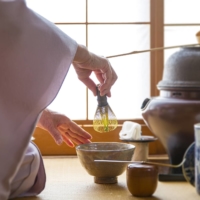Green tea began in China as a medicinal brew, and grew in Japan into an aid to wakefulness and meditation for Zen monks. In time, the ceremony of its preparation became a mode of refinement for a social elite versed in introspection and aesthetics. In the modern age, however, few Japanese have the time or opportunity to sit through the elaborate protocols of tea ceremony.
Tea Life, Tea Mind, by Soshitsu Sen XV
95 pages
WEATHERHILL
Born into a family with deep roots in chanoyu (tea ceremony), Soshitsu Sen XV (now known as Genshitsu Sen), the 15th grand master of the Urasenke school of tea, writes in the 1979 translation of his classic text “Tea Life, Tea Mind” that the ceremony involves little more than the “simple act of serving tea and receiving it with gratitude.”
Breathing new life into the practice, Sen traveled extensively overseas, spreading his doctrine that “peace can be spread by offering a bowl of tea to another.” His talks, lectures and demonstrations were also aimed at promulgating his belief that an appreciation for chanoyu was a prerequisite for an understanding of Japanese culture in general.
In assured, amateur-friendly prose, and drawing on engaging anecdotes as much principles and philosophy, Sen describes his training and initiation into becoming head of Urasenke, a process that involved attaining Zen priesthood, which is a requirement for all grand tea masters.
In Sen’s book, the worship of tea becomes less a mark of connoisseurship and more a social leveling to be enjoyed by all.
In a time of both misinformation and too much information, quality journalism is more crucial than ever.
By subscribing, you can help us get the story right.
SUBSCRIBE NOW
KEYWORDS
tea ceremony, Soshitsu Sen XV



